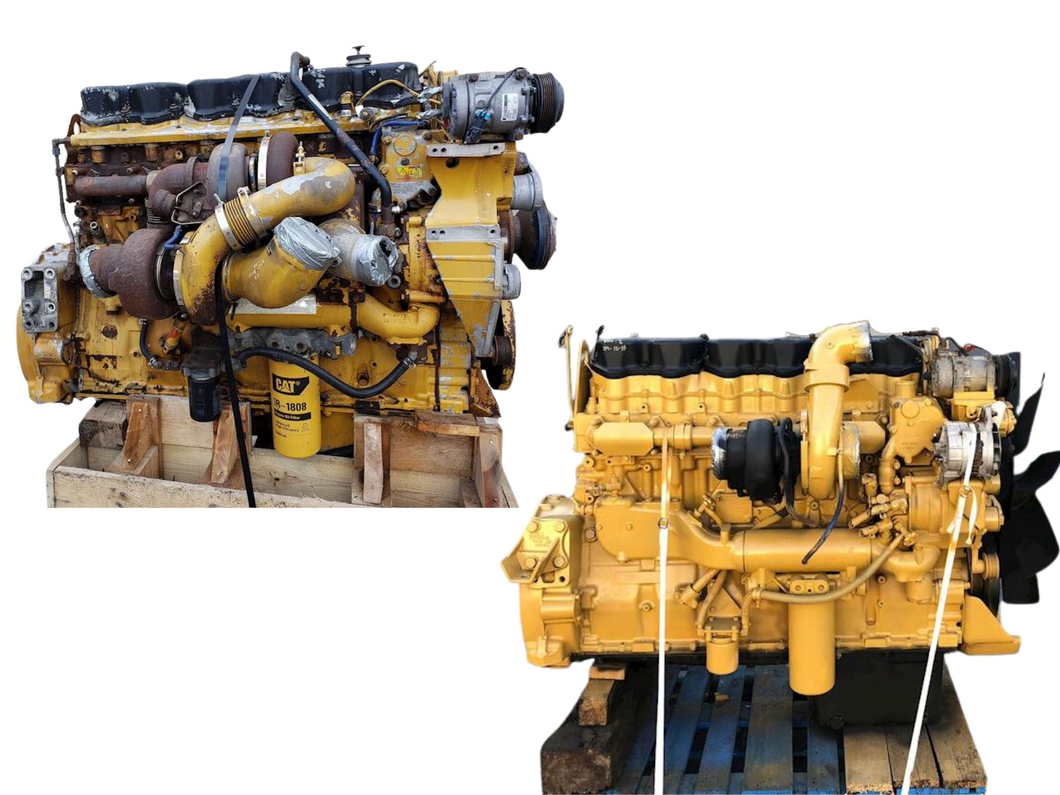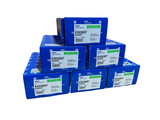Caterpillar C15 | Single Turbo or "Twin" Turbo - What is better?
One of the most frequently asked questions when it comes to mid 2000s Caterpillar engines; Single turbo or “Twin” turbo.
While the factory Acert turbochargers are often referred to as “Twins” they are NOT twin turbos. Twin means the same and the two turbos on Acert engines could not be any more different from one another. Take a look for yourself..
The Acert uses a high pressure (primary) turbo and low pressure (atmospheric) turbo. Contrary to popular belief, the high pressure turbo is actually the smaller turbo in the system and the low pressure is the larger turbo. The high pressure turbo gets exhaust gas first, as it is mounted directly to the exhaust manifold. The low pressure gets spooled by the same exhaust gasses after they exit the exhaust housing of the high pressure turbo. The air filter actually attaches to the inlet of the low pressure turbo, as the outlet of the low pressure turbo flows into the inlet of the high pressure turbo, thus “compounding” boost pressure. Photo courtesy of reddit user "NoPatient1175"

As far as drivability goes, the high pressure turbo spools up first and provides low end power, while the low pressure turbo spools up later to eventually supply the majority of power in the mid and top range of the powerband.
While the Acert compound turbo system is very efficient, it can also be quite a headache overtime & costly to maintain. The complete system includes two turbos, multiple bellows, and a pre-cooler system (a small air to water intercooler system) - separate from the trucks on board CAC system. The pre-cooler is NOT to be confused with an EGR cooler, this pre-cooler is cooling charged air (boost pressure) not exhaust air for emissions control.
All of these components are wear items and when you need to replace a piece of the system, you are not only in for a large parts bill, but a tall labor charge as well. This system takes up some serious space on the passenger side of the motor and makes even small tasks a whole day job.
Before the Acert was introduced, the Caterpillar C15 was a single turbo application. Often referred to as an "E model" as the early C15 and 3406E share countless similarities. Many Acert engine owners opt to convert their turbo system back to a single turbo. This has its positives and negatives just as the compound turbos do.
Single turbo conversions are very popular because they are simple; it’s just one turbo - no bellows, no pre cooler, no extra turbo. This setup leaves much more room to service the engine, making for cheaper and easier maintenance. The single turbo orientation is also more familiar to techs world wide, as it’s the same as the 3406 models that are still abundent in the US and worldwide. Going single turbo also opens up a whole slew of turbo choices, whether you are looking to upgrade for more power or just need a turbo to get you going after breaking down on the road side. You have a much better chance finding a suitable single turbo then the correct compound turbos at any road side parts house.
There is no right or wrong answer when it comes to single turbo or compound turbos on a caterpillar engine, it really comes down to how YOU want to run, maintain, and operate YOUR truck. If you value efficiency, the compounds will likely be the best choice for you. If you value simplicity, the single turbo is the way to go; and the list goes on and on. An argument can be made why either setup is “better”. Its common for folks with Acerts to convert to a single turbo setup, and we have even seen E-model engines have Acert turbos added.
Do you like pancakes or waffles for breakfast? If you don’t expect me to know which one you prefer, then I also can’t tell you if you should single turbo your Acert.
Recent Posts
-
1.32 A/R, 1.45 A/R, or 1.58 A/R - Which one do you have on YOUR Turbo?
The BorgWarner S400 and S410SX turbos are SUPER popular for CAT, Cummins, and Detroit trucks. …11th Jul 2024 -
Factory CAT Replacement Turbochargers - Which one do you need?
When it comes to finding a direct replacement turbocharger for your CAT 3406 engine, there is alot o …3rd Jul 2024 -
Which injectors should I get for my CAT 3406E/C15
If you have a CAT 3406E that is in need of a set of injectors, or you are looking to upgrade the inj …13th Dec 2023




